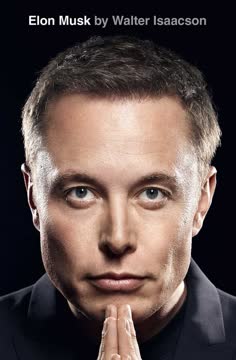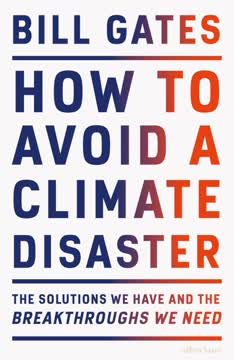Key Takeaways
1. Climate change demands urgent action: We must reach net-zero emissions by 2050
"To avoid a climate disaster, we have to get to zero."
The climate crisis is real and pressing. The world is already experiencing the effects of climate change, including more frequent and severe weather events, rising sea levels, and disruptions to ecosystems. To prevent catastrophic outcomes, we must eliminate our greenhouse gas emissions entirely by mid-century.
The challenge is immense but not insurmountable. Achieving net-zero emissions will require a complete transformation of our energy systems, industrial processes, transportation, and agricultural practices. This transition demands unprecedented cooperation between governments, businesses, and individuals worldwide. While the task may seem daunting, the potential consequences of inaction are far more severe. By setting a clear goal and working diligently towards it, we can avoid the worst impacts of climate change and create a sustainable future for generations to come.
2. Understanding the scale: 51 billion tons of greenhouse gases emitted annually
"Fifty-one billion is how many tons of greenhouse gases the world typically adds to the atmosphere every year."
The scale of the problem is staggering. To truly grasp the challenge we face, it's essential to understand the sheer volume of greenhouse gases we emit each year. This massive quantity comes from various sources:
- Making things (cement, steel, plastic): 31%
- Plugging in (electricity): 27%
- Growing things (plants, animals): 19%
- Getting around (planes, trucks, cargo ships): 16%
- Keeping warm and cool (heating, cooling, refrigeration): 7%
Reducing emissions requires a multifaceted approach. Tackling climate change means addressing all these sectors simultaneously. We need to develop cleaner manufacturing processes, transition to renewable energy sources, implement sustainable agricultural practices, revolutionize transportation, and improve energy efficiency in buildings. By breaking down the problem into these categories, we can better understand where to focus our efforts and measure our progress towards net-zero emissions.
3. Electrification is key: Clean electricity can power various sectors
"If we can figure out how to get all the benefits of cheap, reliable electricity without emitting greenhouse gases, we can solve the single most important thing we must do to avoid a climate disaster."
Clean electricity is a game-changer. By decarbonizing our power grid, we can eliminate emissions from the electricity sector and pave the way for electrifying other carbon-intensive activities. This includes:
- Transportation: Electric vehicles for personal and commercial use
- Heating and cooling: Heat pumps and electric HVAC systems
- Industrial processes: Electric furnaces and machinery
Challenges remain, but solutions are emerging. While renewable energy sources like solar and wind are becoming increasingly cost-competitive, we still need to overcome intermittency issues and develop better energy storage solutions. Advanced nuclear power, geothermal energy, and other emerging technologies may also play crucial roles in creating a reliable, carbon-free electricity system.
4. Innovation is crucial: We need breakthroughs in clean energy technology
"We need lots of breakthroughs in science and engineering."
Current technologies are not sufficient. While we have made significant progress in areas like solar and wind power, many sectors still lack viable zero-carbon alternatives. Key areas requiring innovation include:
- Grid-scale electricity storage
- Zero-carbon cement and steel production
- Sustainable aviation fuels
- Advanced nuclear fission and fusion
- Carbon capture and storage technologies
Investment in R&D is critical. Governments and private sector entities must dramatically increase funding for clean energy research and development. This includes supporting basic scientific research, applied technology development, and demonstration projects to bridge the gap between laboratory discoveries and commercial deployment.
5. Green Premiums: The cost difference between clean and dirty alternatives
"Green Premiums are the price difference between a product that involves emitting carbon and an alternative that doesn't."
Understanding Green Premiums is crucial. These premiums help us identify where clean alternatives are already cost-competitive and where further innovation or policy support is needed. For example:
- Electric vehicles: Becoming increasingly competitive with traditional cars
- Renewable electricity: Often cheaper than fossil fuels in many regions
- Plant-based meat: Still more expensive but prices are dropping rapidly
Reducing Green Premiums is key to adoption. To accelerate the transition to clean technologies, we must focus on driving down these cost differences through:
- Technological improvements
- Economies of scale
- Supportive government policies (e.g., carbon pricing, incentives)
By systematically addressing Green Premiums across all sectors, we can make clean alternatives the economically attractive choice for consumers and businesses alike.
6. Government policies play a vital role in driving climate solutions
"We need to adopt policies that will put us on a path to deep decarbonization by 2050."
Policy is a powerful tool for change. Governments can accelerate the transition to a zero-carbon economy through various mechanisms:
- Carbon pricing: Internalizing the cost of emissions
- Clean energy standards: Mandating the use of low-carbon technologies
- R&D funding: Supporting innovation in critical areas
- Infrastructure investment: Building the foundation for a clean energy future
- Regulations: Setting emissions standards and efficiency requirements
A comprehensive approach is necessary. Effective climate policy must address all sectors of the economy and provide long-term certainty for businesses and investors. This includes coordinating efforts across local, national, and international levels to create a cohesive framework for action.
7. Adaptation strategies are necessary to cope with inevitable climate impacts
"Any plan for climate change needs to include adaptation."
We must prepare for unavoidable changes. Even with aggressive emissions reductions, some degree of climate change is already locked in. Adaptation strategies are crucial to protect vulnerable communities and ecosystems. Key areas of focus include:
- Agriculture: Developing drought-resistant crops and sustainable farming practices
- Infrastructure: Building resilient cities and protecting against sea-level rise
- Water management: Improving water conservation and flood control
- Health systems: Preparing for changing disease patterns and extreme weather events
Adaptation and mitigation go hand-in-hand. While we work to reduce emissions, we must also invest in making our societies more resilient to the impacts of climate change. This dual approach is essential for ensuring a sustainable and equitable future for all.
8. Everyone has a part to play: Individuals, businesses, and governments must act
"You have influence as a citizen, a consumer, and an employee or employer."
Individual actions matter. While systemic changes are necessary, personal choices can make a difference:
- As citizens: Advocate for climate policies and vote for leaders who prioritize action
- As consumers: Choose low-carbon products and support companies committed to sustainability
- As employees or employers: Push for corporate sustainability initiatives and climate-friendly practices
Collective action amplifies impact. By working together across sectors and communities, we can create a groundswell of support for climate action and drive meaningful change at all levels of society.
9. A comprehensive plan: Balancing innovation, policy, and market forces
"Markets, technology, and policy are like three levers that we need to pull in order to wean ourselves from fossil fuels."
A holistic approach is essential. Addressing climate change requires coordinated efforts across multiple domains:
- Innovation: Developing new clean technologies and improving existing ones
- Policy: Creating incentives and regulations to support clean energy adoption
- Markets: Mobilizing private capital and driving demand for low-carbon solutions
Synergy between these elements is key. By aligning technological progress, supportive policies, and market dynamics, we can accelerate the transition to a zero-carbon economy. This requires collaboration between governments, businesses, researchers, and civil society to create a coherent and effective strategy for tackling climate change.
10. The urgency of now: We can't wait to take action on climate change
"We are at the same point today with climate change as we were several years ago with pandemics."
Time is of the essence. The longer we delay action on climate change, the more difficult and expensive it becomes to address the problem. Every year of continued emissions locks in more warming and increases the risk of triggering irreversible tipping points in the Earth's climate system.
We have the tools to start now. While innovation is crucial for long-term solutions, we already have many technologies and strategies that can significantly reduce emissions. By deploying existing clean energy technologies, improving energy efficiency, and implementing nature-based solutions, we can make immediate progress while working on breakthrough innovations. The COVID-19 pandemic has shown that rapid, global action is possible when faced with a crisis. We must bring the same sense of urgency and commitment to addressing climate change, recognizing it as the defining challenge of our time.
Last updated:
FAQ
What's How to Avoid a Climate Disaster about?
- Focus on Climate Change: The book addresses the urgent need to tackle climate change by achieving net-zero greenhouse gas emissions.
- Two Key Numbers: Bill Gates highlights the annual emission of 51 billion tons of greenhouse gases and the necessity of reducing this to zero.
- Solutions and Innovations: It explores existing solutions and necessary breakthroughs in sectors like energy, manufacturing, and agriculture.
Why should I read How to Avoid a Climate Disaster?
- Informed Perspective: The book offers insights from Bill Gates, a leading figure in technology and philanthropy, on the complexities of climate change.
- Actionable Solutions: Gates provides practical solutions for individuals, businesses, and governments to reduce emissions.
- Global Importance: Understanding climate change is crucial, and the book equips readers to engage in meaningful environmental conversations and actions.
What are the key takeaways of How to Avoid a Climate Disaster?
- Need for Zero Emissions: Achieving net-zero emissions is essential to avoid severe climate consequences, requiring changes in energy and goods production.
- Role of Innovation: Technological innovation is crucial for reaching these goals, especially in energy, manufacturing, and agriculture.
- Collective Responsibility: Addressing climate change requires a collective effort from governments, businesses, and individuals.
What are the best quotes from How to Avoid a Climate Disaster and what do they mean?
- "The only sensible goal is zero.": This highlights the necessity of eliminating greenhouse gas emissions to prevent catastrophic climate impacts.
- "We need to deploy the tools we already have, like solar and wind, faster and smarter.": Gates stresses the urgency of using existing renewable technologies to reduce emissions.
- "To avoid a climate disaster, we have to get to zero.": This encapsulates the book's central message of achieving net-zero emissions for future survival.
What are the main sources of greenhouse gas emissions discussed in How to Avoid a Climate Disaster?
- Energy Production: Electricity generation, primarily from fossil fuels, accounts for about 27% of global emissions.
- Manufacturing Processes: Manufacturing materials like cement and steel contribute approximately 31% of emissions.
- Agriculture: Agriculture, forestry, and land use account for about 19% of emissions, with livestock and fertilizer use being major contributors.
How does Bill Gates propose to achieve net-zero emissions in How to Avoid a Climate Disaster?
- Innovative Technologies: Gates advocates for breakthrough technologies to reduce emissions in energy, manufacturing, and agriculture.
- Government Policies: Supportive policies are crucial for incentivizing clean energy investments and innovation.
- Individual Actions: Gates encourages personal responsibility through informed choices and advocacy for climate-friendly practices.
What challenges does Gates identify in reaching zero emissions in How to Avoid a Climate Disaster?
- Intermittency of Renewables: Reliance on solar and wind requires reliable storage solutions due to their intermittent nature.
- Economic Barriers: The current system favors fossil fuels, making it hard for clean energy to compete without policy changes.
- Global Cooperation: Achieving global consensus is difficult due to varying priorities and development levels among countries.
What role does innovation play in How to Avoid a Climate Disaster?
- Essential for Solutions: Innovation is crucial for developing technologies to reduce emissions in hard-to-decarbonize sectors.
- Driving Down Costs: Technological breakthroughs can lower costs for clean energy, making them more accessible.
- Encouraging Investment: A culture of innovation attracts investment in clean technologies, necessary for scaling solutions.
How does How to Avoid a Climate Disaster address the issue of energy poverty?
- Access to Clean Energy: Gates emphasizes providing reliable, affordable clean energy to low-income countries.
- Link to Climate Goals: Solutions must ensure that the poorest benefit from clean energy without increasing emissions.
- Innovative Solutions: The book highlights potential technologies to provide affordable, scalable clean energy in developing regions.
What specific technologies does Gates highlight in How to Avoid a Climate Disaster?
- Carbon Capture and Storage: Important for reducing emissions from fossil fuel plants and industrial processes.
- Nuclear Power: Advocated as a reliable, carbon-free energy source to meet global electricity demands.
- Renewable Energy: Emphasizes rapid deployment of solar and wind technologies and advancements in energy storage.
How can individuals contribute to climate action according to How to Avoid a Climate Disaster?
- Making Informed Choices: Educate yourself and support sustainable practices like reducing energy consumption.
- Advocating for Change: Support policies promoting clean energy and innovation at all levels.
- Supporting Innovation: Invest in or support companies focused on reducing emissions and developing sustainable solutions.
What is the significance of the Green Premium discussed in How to Avoid a Climate Disaster?
- Understanding Cost Differences: The Green Premium is the extra cost of low-carbon alternatives over fossil fuels.
- Impact on Adoption Rates: High premiums deter adoption; reducing them is crucial for a zero-carbon economy.
- Role of Innovation: Innovation in technology and policy is needed to lower the Green Premium and make clean solutions viable.
Review Summary
How to Avoid a Climate Disaster receives mixed reviews. Many praise Gates' accessible explanation of climate change and proposed solutions, particularly his focus on innovation and technology. Critics argue he downplays individual action and behavioral changes. Some question his credibility as a billionaire with a large carbon footprint. The book is seen as a good introduction for beginners, but lacking depth for those already knowledgeable about climate change. Gates' optimism and emphasis on government and industry action are both commended and criticized.
Similar Books








Download PDF
Download EPUB
.epub digital book format is ideal for reading ebooks on phones, tablets, and e-readers.






